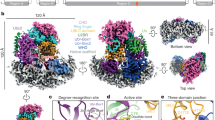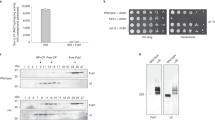Abstract
The UBA domain is a motif found in a variety of proteins, some of which are associated with the ubiquitin–proteasome system1,2. We describe the isolation of a fission-yeast gene, mud1+, which encodes a UBA domain containing protein that is able to bind multi-ubiquitin chains. We show that the UBA domain is responsible for this activity. Two other proteins containing this motif, the fission-yeast homologues of Rad23 and Dsk2, are also shown to bind multi-ubiquitin chains via their UBA domains. These two proteins are implicated, along with the fission-yeast Pus1(S5a/Rpn10) subunit of the 26 S proteasome, in the recognition and turnover of substrates by this proteolytic complex.
This is a preview of subscription content, access via your institution
Access options
Subscribe to this journal
Receive 12 print issues and online access
$209.00 per year
only $17.42 per issue
Buy this article
- Purchase on Springer Link
- Instant access to full article PDF
Prices may be subject to local taxes which are calculated during checkout




Similar content being viewed by others
References
Hofmann, K. & Bucher, P. Trends Biochem. Sci. 21, 172–173 (1996).
Hershko, A. & Ciechanover, A. Annu. Rev. Biochem. 67, 425–479 (1998).
Voges, D., Zwickl, P. & Baumeister, W. Annu. Rev. Biochem. 68, 1015–1068 (1999).
Deveraux, Q., Ustrell, V., Pickart, C. & Rechsteiner, M. J. Biol. Chem. 269, 7059–7061 (1994).
Van Nocker, S., Deveraux, Q., Rechsteiner, M. & Vierstra, R. D. Proc. Natl Acad. Sci. USA 93, 856–860 (1996).
Haracska, L. & Udvardy, A. Eur. J. Biochem. 231, 720–725 (1995).
Van Nocker, S., et al. Mol. Cell. Biol. 16, 6020–6028 (1996).
Wilkinson, C. R. M. et al. J. Biol. Chem. 275, 15182–15192 (2000).
Wilkinson, C. R. M., Wallace, M., Seeger, M., Dubiel, W. & Gordon, C. J. Biol. Chem. 272, 25768–25777 (1997).
Schauber, C. et al. Nature 391, 715–718 (1998).
Lombaerts, M., Goeloe, J. I., den Dulk, H., Brandsma, J. A. & Brouwer, J. Biochem. Biophys. Res. Commun. 268, 210–215 (2000).
Biggins, S., Ivanovska, I. & Rose, M. D. J. Cell Biol. 133, 1331–1346 (1996).
He, X., Jones, M. H., Winey, M. & Sazer, S. J. Cell Sci. 111, 1635–1647 (1998).
Bertolaet, B. L. et al. Nature Struct. Biol. 8, 417–422 (2001).
Sambrook, J. & Russell, D. Molecular Cloning (Cold Spring Harbor Laboratory, Cold Spring Harbor, New York; 2000).
Bahler, J. et al. Yeast 14, 943–951 (1998).
Benito, J., Martin-Castellanos, C. & Moreno, S. EMBO J. 17, 482–497 (1998).
Gordon, C., McGurk, G., Wallace, M. & Hastie, N. D. J. Biol. Chem. 271, 5704–5711 (1996).
Dubiel, W. & Gordon, C. Curr. Biol. 9, R554–R557 (1999).
Moreno, S., Klar, A. & Nurse, P. Methods Enzymol. 194, 793–823 (1990).
Beal, R. E. et al. Proc. Natl Acad. Sci. USA 93, 861–866 (1996).
Acknowledgements
We thank W. Dubiel and K. Ferrell for advice and help with multi-ubiquitin binding experiments; C. Landgraf and R. Volkmer-Engert for advice on the BIAcore experiments; R. Layfield for advice on using the anti-ubiquitin antibody for western blot analysis; S. Moreno for the anti-Rum1 antibody; P. McLaughlin for spotting the homology between the Mud1 protein and the aspartate protease; C. Pickart for providing lysine-48-linked multi-ubiquitin chains and for comments on the manuscript; P. Perry for advice on microscopy; S. Bruce, D. Stuart and N. Davidson for photography; and K. Hendil and N. Hastie for advice, encouragement and comments on the manuscript. This work was supported by Medical Research Council funding (to C.G.), the Danish Research Academy (to R.H.-P.) and the Deutsche Forschungsgemeinschaft (to M.S.).
Author information
Authors and Affiliations
Corresponding author
Supplementary information
Supplementary figures
Figure S1 Proteins in fission yeast containing a UBA domain. (PDF 23 kb)
Figure S2 Surface plasmon resonance measurements of Mud1 binding to tetra-ubiquitin.
Rights and permissions
About this article
Cite this article
Wilkinson, C., Seeger, M., Hartmann-Petersen, R. et al. Proteins containing the UBA domain are able to bind to multi-ubiquitin chains. Nat Cell Biol 3, 939–943 (2001). https://doi.org/10.1038/ncb1001-939
Received:
Revised:
Accepted:
Published:
Issue Date:
DOI: https://doi.org/10.1038/ncb1001-939
This article is cited by
-
Arabidopsis thaliana ubiquitin-associated protein 2 (AtUAP2) functions as an E4 ubiquitin factor and negatively modulates dehydration stress response
Plant Molecular Biology (2024)
-
Lysine deserts prevent adventitious ubiquitylation of ubiquitin-proteasome components
Cellular and Molecular Life Sciences (2023)
-
The high stability of the three-helix bundle UBA domain of p62 protein as revealed by molecular dynamics simulations
Journal of Molecular Modeling (2021)
-
TNK1 is a ubiquitin-binding and 14-3-3-regulated kinase that can be targeted to block tumor growth
Nature Communications (2021)
-
The proteasome 19S cap and its ubiquitin receptors provide a versatile recognition platform for substrates
Nature Communications (2020)



